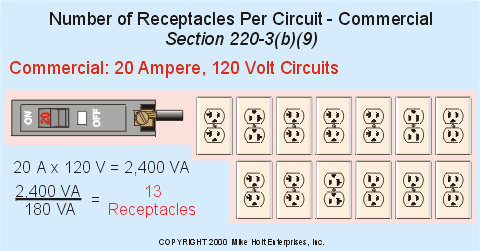I was just curious. When sizing panels for non-residential building we have to calculate a load of 180VA for each receptacle. Is there anything that says if it should be calculated as a continuous load? I can see an arguement for it either way. If there's nothing plugged in then there's no peak amp draw. But if the Code tells us to calculate at 180VA then for calculation purposes it's always on. I'm looking for any diffinitive answers. Thanks.
You are using an out of date browser. It may not display this or other websites correctly.
You should upgrade or use an alternative browser.
You should upgrade or use an alternative browser.
Are default receptacle loads continuous?
- Thread starter Mr. Bill
- Start date
- Status
- Not open for further replies.
- Location
- Chapel Hill, NC
- Occupation
- Retired Electrical Contractor
I was just curious. When sizing panels for non-residential building we have to calculate a load of 180VA for each receptacle. Is there anything that says if it should be calculated as a continuous load? I can see an arguement for it either way. If there's nothing plugged in then there's no peak amp draw. But if the Code tells us to calculate at 180VA then for calculation purposes it's always on. I'm looking for any diffinitive answers. Thanks.
You calculate the load at 180 va and that's it.
- Location
- Lockport, IL
- Occupation
- Semi-Retired Electrical Engineer
I agree. The value of 180 VA is actually small, in relation to the amount of power many plug and cord connected loads are likely to draw. It is only one and one half amps. A common hair dryer will draw ten or more amps. We get to use the value 180 out of an expectation that during the time that that one hair dryer is in use, there are a bunch of other receptacles that are not in use. It is an average value, and it takes into consideration that some loads (floor lamps, for example) might be on for 3 or more hours, while other loads (hair dryers, for example) might only be on for a few minutes a day.
Ben Franklin
Banned
- Location
- Philadelphia, PA
Sometimes it's best to take the code for what it says and not read too much into it. Article 220 is well on the conservative side in most cases, thus I would not try to find ways to increase my load calculations when not necessary or not clearly required by the code. That is my advice.
So ignoring for the sake of example the fact that different recepcale circuits are required for different areas (eg. sepearte circuit for bathroom) and using the value of 180VA per receptacle (1.5A) that would tell me that you can have up to 13 different receptacles on a 20A circuit?
- Location
- Lockport, IL
- Occupation
- Semi-Retired Electrical Engineer
That is not a bad notion, if you need to make a design decision regarding how many you wish to put on a circuit. But it is not an NEC requirement. Some may argue. Some have. Please do a search for other threads that discuss this issue, before hijacking this thread to bring it up again.. . . that would tell me that you can have up to 13 different receptacles on a 20A circuit?
And that's what I've done. But my mind started wondering 'what if'. And maybe someone else may have questioned this. Sometimes it's good to think hypothetical ways to interpret something and find arguements against that rational. I think the fact that we can derate by 50% anything over 10kVA on a panel would imply that these are not continuous loads. Just wondering if anyone knew of anything more definitive.You calculate the load at 180 va and that's it.
I was just curious. When sizing panels for non-residential building we have to calculate a load of 180VA for each receptacle. Is there anything that says if it should be calculated as a continuous load? I can see an arguement for it either way. If there's nothing plugged in then there's no peak amp draw. But if the Code tells us to calculate at 180VA then for calculation purposes it's always on. I'm looking for any diffinitive answers. Thanks.
Michael Holt, Electrical Exam Preparation, 1st Edition 1999, Section 11-15:
"The minimum load for each commercial and industrail general use receptacle outlet shall be 180VA per strap. Receptacles are generally not considered to be continuous load"
**
I wish the NFPA would clarify in the NEC more so what precisely is continuous and what isn't continuous in one of their many tables that are so ubiquitous in their code book. Holt says certain commercial establishments are "assumed" continuous and others are not. It doesn't even state that if something isn't deemed continuous then it must be non-continuous.
It's more confusing than it needs to be, that is for sure.
Ron.
iaov
Senior Member
- Location
- Rhinelander WI
You can put a hundred outlets on a twenty amp circuit if you want!!So ignoring for the sake of example the fact that different recepcale circuits are required for different areas (eg. sepearte circuit for bathroom) and using the value of 180VA per receptacle (1.5A) that would tell me that you can have up to 13 different receptacles on a 20A circuit?
- Location
- Chapel Hill, NC
- Occupation
- Retired Electrical Contractor
You can put a hundred outlets on a twenty amp circuit if you want!!
I guess Mike Holt would disagree but we have all been down this road before. This is obviously from an older code book

iaov
Senior Member
- Location
- Rhinelander WI
I'm afraid I am showing my resi thinking. I don't believe there is a limit on the number of outlets I can put on a house circuit. PS Nice picture.
- Status
- Not open for further replies.

